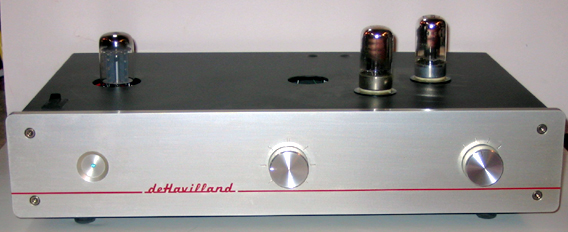|
The Blue Velvet Line Preamplifier: An Update
by Dick Olsher

Since its publication in November 2003 (Blue Velvet), the Blue Velvet (BV) line preamp design has undergone a couple of modifications; really not bad for a seven-year old design! The intention of this update is to describe these mods, share additional findings, as well as present the updated schematics.
The power supply was modified by the addition of a 1N5406 rectifier diode - just before the glow tubes. Its purpose is to isolate the 0A2 glow tubes from the large capacitors in the filter network and prevent oscillation. The diode effectively decouples the glow tubes over their entire working current range, and it works like a charm in this application. Kara now recommends a beefier rectifier bridge - 8A minimum.
The signal path circuit’s output coupling capacitor (C2) was increased in value to a total of 4.7 µF. For me that means a Cardas 0.68 uF in parallel with a 4 uF Hovland Musicap (which I still have on hand from years ago). Since Hovland is now out of business, please feel free to experiment with your favorite types. The increase in capacitance is responsible for enhanced bass extension, especially with low input impedance solid-state amps.
Although not indicated on the schematic, I have by now switched from the original Noble volume pot to a TKD stepped attenuator. The increased levels of clarity and soundstage transparency were quite startling. In hindsight, I can say that the upgrade to a high-quality stepped attenuator is well worth the added expense.
For the past couple of years I have been using almost exclusively Loktal types (7N7 and 7AF7) instead of 6SN7s. They are similar in terms of tube parameters, but because they use a different pinout you’ll need to use a 6SN7 to 7N7 adapter if you’ve already wired the BV for 6SN7 use. Loktal (for Lock-In), was a trademark of Philco-Sylvania. Other manufacturers (e.g., Tung Sol and Raytheon) referred to them as loctals. They are a bit funky looking with a central metal spigot, short pins that are essentially thickened lead out wires, and a metal base shell. The 7N7 has already developed a reputation as an inexpensive yet excellent alternative to vintage 6SN7 types, and I did in fact find it superior to almost all vintage 6SN7s in my collection as far as detail retrieval and spatiality. As good as the 7N7 is, the 7AF7 sounds even sexier, and is currently my top choice for the BV.
Bottom line: I’m still enjoying the BV after all these years. Its convincing tonality, rich colors, and tremendous boogie factor make for an enchanting musical experience.
|